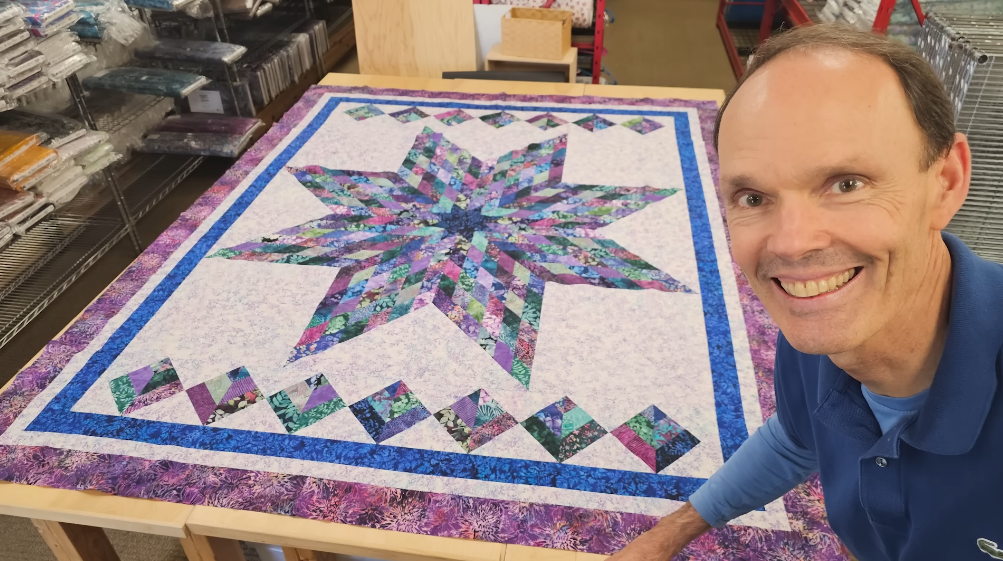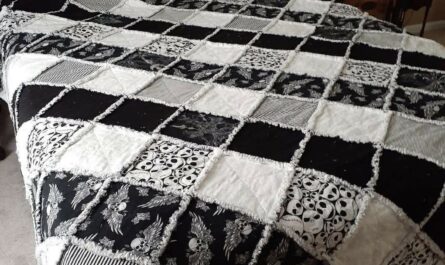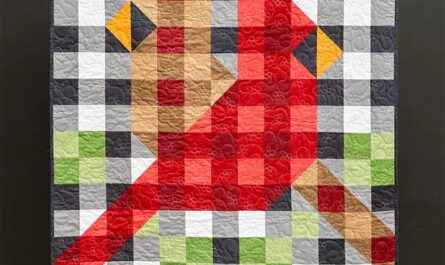Quick overview
- Pattern: Lone Star (Donna & Matt / Jordan Fabrics — free pattern).
- Typical sample sizes shown by Jordan Fabrics include small wall-hangings up to large bed quilts; the shop also shows a finished 32″×32″ wall-hanging sample in their listings.
- Construction method used in the video: strip-piecing to create long diamond/star points, then trim and join star points to form the eight-point Lone Star.
Materials & tools (workshop-ready)
- Assorted fabrics for star points: lots of strips in a coordinated colorway (scrappy or planned gradient). Use a jelly-roll, fat quarters cut into strips, or yardage cut into strips.
- Background/setting fabric(s): a solid or low-value print for negative space and border.
- Fabric for border and binding.
- Batting sized a bit larger than final top.
- Backing fabric.
- Tools: rotary cutter, cutting mat, long ruler (24″+), small square ruler, diamond or equilateral triangle ruler optional, sewing machine with accurate ¼” foot, pins/clips, iron/pressing board, marking pen.
- Optional but helpful: a diamond ruler or Lone Star ruler (many quilters use a specialty ruler to cut star diamonds cleanly), or use strip-set sub-cut and trimming method shown in the video.

Before you start
- Decide finished size (wall hanging, throw, bed). The pattern includes size options — if you want the exact cutting counts, use the free pattern’s cut list.
- Choose whether you’ll make the star scrappy (many different fabrics) or controlled (a limited gradient). The video shows a striped/strip-pieced star where strips of fabric create banded diamonds that read as long star points.
General cutting approach (what you’ll do)
Jordan Fabrics’ method in the video is strip-piecing heavy — sew long strip sets first, then sub-cut and trim diamonds. The pattern gives exact strip widths and counts for each finished size; the steps below follow the same order but use descriptive dimensions so you can match your chosen size.
- Cut long strips from each star fabric. Common working widths for strip sets are 2½” or 3″ (many Lone Star tutorials use these widths), but follow the pattern if you want identical results.
- Cut background strips and border strips as the pattern specifies.
- Sew strip sets — alternating colored strips and narrow background strips as the design requires — into long strip units. Press strip sets flat.
Step-by-step construction (follow this at your machine)
Step 1 — Make strip sets for star points
- Chain-piece long strips together in the order you want the star point to read (for example: several colored strips arranged from dark → light → dark to create a banded point). Press seams after each seam or press entire strip set open/flat as you prefer. The video shows sewing long strip sets wide enough so that when sub-cut and trimmed they form long diamonds that make the star points.
Step 2 — Sub-cut strip sets into diamonds (or diamond blanks)

- From each strip set, sub-cut segments lengthwise to create blanks that will become diamonds. There are two common methods:
- Ruler method: Use a Lone Star / diamond ruler to mark and cut diamonds directly from the strip set. This yields precise diamond shapes with all seams contained in the diamond.
- Strip-subcut + square-and-trim method (what Jordan Fabrics often demonstrates): Sub-cut the strip set into wide rectangles, then cut squares on the diagonal or use a template to make oversized diamond blanks and trim each to the precise diamond shape (trim to the pattern’s diamond measurement). The video demonstrates trimming/star-point trimming so the points match.
Step 3 — Make star points (assemble diamonds into long points)
- Each star point is usually made of several diamonds sewn tip-to-tip (or edge-to-edge) to create a long, tapering point. Lay out the diamonds in the order you want (colour gradation matters here) then sew the diamond pieces together along their long edges with a ¼” seam allowance. Press seams carefully — press toward the darker fabric or open, depending on bulk. The star has eight of these points.
Step 4 — Trim and square each star point
- After joining the diamonds into long points, square up each point to the pattern’s recommended length and width (this ensures perfect meeting at the center and proper fit into the background setting). Accurate trimming is essential: small errors magnify when eight points meet. The video emphasizes careful trimming and checking seam nesting before joining points.
Step 5 — Join the eight star points to form the Lone Star

- Arrange the eight star points around a central square/diamond (the pattern shows whether a central medallion is used or the center is simply the meeting point of points). Pin the points together at the center and sew pairs first, then sew the pairs together until the full star is formed. Press seams gently and check alignment often — match seam intersections at the center carefully to keep the star flat. The Jordan Fabrics demo shows how the points interlock; take time pinning and matching seam allowances.
Step 6 — Add setting triangles / background pieces
- The Lone Star is commonly set into a square of background with triangular wedges filling the corners and sides. Cut and sew the background triangles and filler pieces to the star top as the pattern directs. This step turns the pieced star medallion into a framed square quilt center. Accuracy here will keep the borders straight and square.
Step 7 — Add inner borders, log cabin frames (optional), and outer borders
- Depending on the pattern variation you’re following (some Jordan Fabrics kits add log-cabin blocks or framed borders around the star), add the borders in order: inner narrow border first, then wider outer borders. Press and square the quilt top after each border sewn. Jordan Fabrics sometimes shows a log-cabin & star layout where additional log-cabin blocks surround the star; if you want that look, make the prescribed number of log-cabin blocks and stitch them into the layout before final borders.
Step 8 — Baste, quilt, and bind

- Baste the quilt sandwich (top + batting + backing) with pins or spray baste. Quilt in a style that shows the star — radiating echoes from the center or diagonal cross-hatching works beautifully. Jordan Fabrics’ samples often use an overall edge-to-edge quilting motif on smaller samples and echo quilting to emphasize the star on larger quilts. Trim and bind with your chosen binding method.
Pressing, seam, and accuracy tips (from the video & pattern)
- Always use a consistent ¼” seam allowance for piecing — Lone Star accuracy depends on consistent seams.
- Press seams in a consistent direction or open — pressing to one side helps nest seams but can add bulk; pressing open reduces bulk at the center. The video shows pressing choices that reduce bulk where many seams meet.
- Trim early and often. After joining diamond pieces or strip-sets, trim each unit to its final dimension before assembly. This prevents cumulative error.
- Pin the center carefully. When the eight points meet, pin the center and sew slowly; match points exactly so the center looks sharp and the star lies flat.

Optional variations & styling ideas
- Make a scrappy Lone Star using many different strips for a vintage scrappy look.
- Use a single-color gradient from light to dark for each point to build an ombré star.
- Surround the star with log-cabin blocks or framed sashings to turn a medallion into a full-sized bed quilt — Jordan Fabrics shows examples of framed star + log cabin layouts in their gallery.
Final notes
- The Jordan Fabrics tutorial demonstrates the exact workflow and trimming/assembly rhythm — watch the video as you sew to match the techniques shown (strip-piecing, sub-cutting, diamond trimming, careful center joining).
- For the precise cut list and finished measurements for the size you want to make, use the Lone Star free pattern from Jordan Fabrics — it contains the exact diamond dimensions, strip widths, and counts for each size.
VIDEO:



